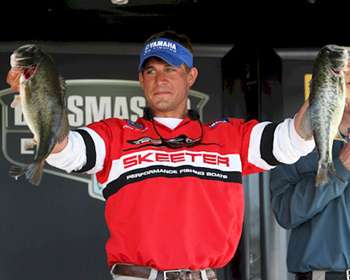
Take one look at the soft plastic aisle in a tackle store and it's no secret that plastics come in just about every color imaginable. Need a pink Fluke? They've got them. How about a Blue Sapphire lizard? No problem. Even with all of the color options available on the market, some bass anglers believe there are times when a plastic bait needs a little extra flash.
Count 2010 Elite Series rookie Keith Poche among the group of anglers who like to add extra color to their soft plastics. "When I'm throwing a football or finesse jig with a twin-tail grub as a trailer, 90 percent of the time I will dip or paint the very tip of the grub tails with a chartreuse dye," he explains.
Poche believes that the added splash of color helps generate a reaction strike from bass that are accustomed to seeing certain colors on a regular basis.
"All that I'm doing by dying the plastic is looking to generate a little flash when the jig goes by a fish. It's something that differentiates the bait from the baitfish and crawfish that are in the same area," says Poche. Aside from the tangible benefits, Poche says that tipping his trailer with a hint of color gives him a boost of confidence. "It's just something that I have a lot of confidence in.
Just about every jig that I throw has a little dye on the tip of the trailer." With a variety of dye applications on the market, including sprays, dips and markers, Poche says that he prefers to use markers because they allow for precise and clean application. It was this precision that paid off in a recent tournament where Poche was fishing in the same area as a competitor. "I noticed that he was spraying chartreuse dye on a lot more of the trailer than I was.
I was just barely dying the tip with a marker and I ended up getting a lot more bites. I think that small adjustment made a big difference," he says. Poche also believes that tipping the trailer with a chartreuse or colored dye becomes even more important when targeting spotted bass.
"Most of the time, I'll start out with just a little bit of color on the trailer, but if I'm fishing for spotted bass I'll dip or color a lot more of the trailer. For some reason, I think that it really helps with spotted bass more than largemouth. While most anglers will add chartreuse or orange to the tail of a bait to increase visibility in muddy water, Poche will even add color when fishing clear water like Smith Mountain Lake in Virginia.
However, rather than coloring the flat side of the trailer, he will delicately dye the thin edge of the trailer to create a hint of color. "When those tails go by a bass and they're fluttering, the dye on the tips of the grub tail gets their attention and creates a reaction bite," says Poche.
(Provided by Z3 Media)




